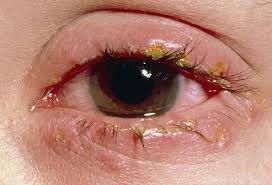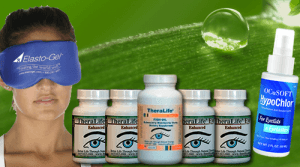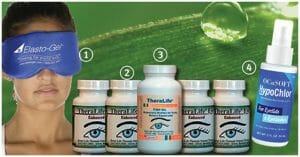What is crusty eyes?
Crusty eyes occur when discharge from the eye dries on the lids, lashes, or corners of the eye, creating a crusty effect. When the discharge is still wet, it may make the eyes sticky.
A small amount of discharge in the corners of the eyes is normal. However, sometimes eye discharge is a symptom of an eye infection or health condition.
Powerful Treatment To Get Rid Of Crusty Eyes- TheraLife
TheraLife addresses several aspects of crusty eyes, clogged meibomian oil glands located on your eyelids, dry eyes, styes, blepharitis, chalazion.
TheraLife All In One Starter kit
Everything you need to get rid of crusty eyes, treat chronic dry eyes, blepharitis and meibomian gland dysfunction
Add To Cart
What is in the starter kit
- TheraLife Eye Capsules to revive and restore tear production intra0cellularly
- Omega-3 Fish Oil- ant-inflammatory, lubrication to thicken tears
- Hot Compress – to melt blockage in oil glands
- Avenova Eyelid Cleanser- eyelid hygiene, treats blepharitis & dry eye recovery
Customer Success Stories
Crusty Eyes– Blepharitis/Meibomian Gland Dysfunction – Relief in 2 weeks.
Two weeks since I started the Theralife Enhanced and I must say that I have experience everything you mentioned in your email:
Moist eye, less sensitivity to light, less grittyness in my eye. I will continue taking the recommended number of tablets each day. The last thing I want to do is to start over.
I went to see my doctor yesterday. He said I have ocular rosacea. He prescribed the AzaSite eye drop and doxcycline Monohydrate oral. From what I read, AzaSite is very effective for treating MGD.
I cant wait for the day when I don’t have to think about my eyes all the time.
I will keep you informed for my progress.
Thank you
D.A Kenmore, WA USA
Why It Works?
TheraLife is an all-natural, patented oral formula designed to restore and revive tear functions from the inside out. TheraLife treats all three crusty eye conditions all at once. It is the only treatment you need. To learn more, click here
A person with symptoms of an eye condition must seek medical help to get the proper treatment- especially true for infants with eye symptoms.
However, while waiting for the condition to improve, there are a few ways to manage crusty or sticky eyes at home.
Good eye hygiene may help improve crusty eyes. We highly recommend Avenova eyelid to stop bacterial infections of your eyelids (blepharitis)
Suppose a person is unsure what type of eye condition they have or have an infection that could be contagious. In that case, they should wash their hands for 20 seconds after touching the eye area. They also should not share or re-use washcloths, towels, or cotton wool that has touched the spot.
To relieve symptoms of pink eye, dry eye, or styes, a person should use warm compresses and OTC eye drops for hydration. Pain medications, such as acetaminophen (Tylenol) or ibuprofen, will reduce pain or swelling. Still, they will not treat an active infection.
A person with an eye infection should avoid using contact lenses and only use a fresh pair once the infection has cleared. A person should also avoid using eye makeup and false eyelashes while they have an eye condition.
blepharitis, chalazion.
TheraLife All In One Starter kit
Everything you need to get rid of crusty eyes, treat chronic dry eyes, blepharitis and meibomian gland dysfunction
Add To CartWhen do you ask for help for crusty eyes?
A person should seek out medical attention if:
- their eye produces a large amount of discharge
- their eye makes green, yellow, or white discharge
- it isn’t easy to open the eye
- the eye is red, swollen, or painful
- they are sensitive to light
- they have blurry vision
In this blog, we will look at the causes for crusty eyes, treatments, home remedies and self-care, and how to prevent crusty eyes.
TheraLife All In One Starter kit
Everything you need to treat chronic dry eyes, blepharitis and meibomian gland dysfunction
Add To CartCauses of crusty eyes
Good eye hygiene may help prevent crusty and sticky eyes.
Sleep
People often refer to the small amount of discharge the eyes produce during the night as “sleep” or “sleep eye.” This tiny pebble-like residue found in the eyes’ corners is not a cause for concern, as it is part of the eye’s protective barrier.
The eye produces a small amount of mucus and oils to stay moist. But during sleep, when a person is not blinking, the discharge can collect in the corners. The discharge can be crusty, sticky, thick, thin, white, transparent, or slightly yellow.
Typically, a person with a small amount of sleep in their eyes upon waking does not require medical treatment unless they have other symptoms.
Pink eye
Pink eye, or conjunctivitis, is another common cause of crusty eyes. Viral or bacterial infection can cause pink eye.
Viral pink eye usually gets better on its own in 1–2 weeks. However, the bacterial pink eye requires antibiotics.
Both viral and bacterial conjunctivitis are contagious, so a person with this condition should take care to wash their hands thoroughly and avoid touching their eyes. The symptoms of conjunctivitis include:
- pink, red or puffy eyes
- itchy or burning eyes
- watery eyes
- white, yellow, or green fluid discharge
- crust along the eyelids or eyelashes
Eye infections in babies can be severe. A parent or caretaker who notices these symptoms in a newborn should call a doctor immediately.
Allergic conjunctivitis
Allergic conjunctivitis has similar symptoms to viral or bacterial eye infections, but it is caused by an allergic reaction instead. Common allergens that cause eye symptoms include pollen, pet dander, and dust mites.
The symptoms of allergic conjunctivitis include:
- itchy eyes
- watery eyes
- eye discharge
- swelling
- symptoms in both eyes
A person with allergies may find that their eyes produce more discharge when their symptoms flare up. When that discharge dries, the eye area may become crusty or sticky.
If a person suspects that they have an allergy, they should speak to a doctor to determine what kind of allergies they have. Over-the-counter (OTC) artificial tears and allergy medications can ease itching and eye dryness.
Dry eye
If a person’s eyes do not produce enough tears, this may also cause crusty eyes. Here are some of the dry eye causes:
- stinging or burning
- blurred vision
- a scratchy or gritty feeling in the eye
- strings of mucus in or around the eyes
- red or irritated eyes
- pain while wearing contact lenses
- more tears
It may seem counterintuitive that dry eye would cause more tears. However, this results from the eye overcompensating for the dryness by producing more moisture than usual. Learn more about watery, dry eyes.
People with a dry eye see an opthalmologist for an eye exam. They may recommend using hydrating eye drops or a humidifier in the home and avoiding irritants, including environmental triggers like cigarette smoke.
Learn more about dry eye here.
Stye
A stye is an inflamed oil gland on the rim of the eyelid that can cause crusty eyes. Often the formation of a stye is related to dry eyes, which causes inflammation to cause clogging of the meibomian oil glands. To learn more, click here
A stye looks similar to a pimple and produces:
- redness
- swelling
- discharge
To treat a stye, a person should apply a warm compress to the area several times a day. The warm compress will help drain the blocked pore. A doctor might prescribe an antibiotic ointment, drops, or a topical steroid to accelerate healing in some cases.
If a stye does not respond to these treatments, a doctor may surgically drain the stye. In rare cases, an untreated stye leads to infection in other parts of the eye.
Blocked tear duct
A blocked tear duct occurs when something obstructs the eye’s drainage system. This means tears cannot drain from the eye. This causes watery, irritated eyes and sometimes leads to an eye infection.
The following symptoms for an eye infection:
- eye mucus discharge
- crusty eyelashes and eyelids
- swelling, tenderness, and redness
- blurred vision
- blood-tinged tears
- fever
An eye doctor should check for a blockage in someone with symptoms of a blocked tear duct and flush the eye out with fluid.
If the ophthalmologist suspects the blockage is due to an infection, they may prescribe antibiotics. If the blockage keeps coming back, a person may need surgery to widen the tear ducts.
Blocked tear ducts in babies
Babies often have blocked tear ducts during the first few years. Newborns, in particular, are prone to this condition because their tear ducts are less developed.
The blocked duct usually produces a sticky yellow or white substance along with the eye, sometimes making it difficult for a baby to open its eyes.
Sometimes, the baby’s eye will become infected or irritated by the blocked tear duct and need treatment from a doctor.
A person should use a damp, clean cotton ball to clean each eye. This will prevent spreading an infection from one eye to the other.
For most newborns, the ducts will open on their own within a few months. A doctor can irrigate the duct during this time to help with symptoms if necessary. They can also show new parents a facial massage technique that can encourage the ducts to open and allow the tears to drain away.
Find out more about blocked tear ducts in babies.
blepharitis, chalazion.
TheraLife All In One Starter kit
Everything you need to get rid of crusty eyes, treat chronic dry eyes, blepharitis and meibomian gland dysfunction
Add To CartBlepharitis- Crusty Eyes
Blepharitis is a condition that causes inflammation of the eyelids. Other symptoms include:
- redness
- swelling
- burning or soreness
- oily particles or crust along the eyelids and lashes
All people have bacteria and other microorganisms on their skin. People with blepharitis may have more bacteria near the lash line than others or have an inflammatory reaction to them where others do not.
This condition is caused by invisible mites called Demodex folliculorum or flaky skin conditions, such as dandruff.
A person with blepharitis can manage the symptoms through good eye hygiene and, if appropriate, by treating the underlying cause. For example, if dandruff is causing blepharitis, treating dandruff will improve symptoms.
Other infections
Fungal keratitis and herpes keratitis can also cause the eye to produce a crusty discharge. Numerous infections of the eye have similar symptoms, such as:
- eye pain
- redness
- blurred vision
- swelling
- sensitivity to light
- eye discharge
Treatment for crusty eyes
The treatment for crusty eyes will depend on the underlying cause. A person will need to see a doctor for the exact diagnosis and correct treatment.
Most doctors will treat crusty eyes with medication that fits the condition, such as:
- oral or topical antibiotics for bacterial infections
- antifungal medicines for fungal infections
- antiviral drugs for viral infections
- antihistamines for allergic reactions
If medication does not work for someone who has a stye or a blocked tear duct, a doctor may recommend surgery.
TheraLife All In One Starter kit
Everything you need to treat chronic dry eyes, blepharitis and meibomian gland dysfunction
Add To CartFrequently Asked Questions
What causes crusts in your eyes?
Crusty in your eyes is also called Blepharitis. Causes of blepharitis include dry eyes, allergic conjunctivitis, pink eye, bacterial and viral infections, ocular rosacea, meibomian gland dysfunction, blocked tear ducts especially in babies.
How do I get rid of crusty eyes?
Treatment for crusty eyes include warm compresses, eyelid cleansing, treating dry eyes, steroid eye drops, antibiotic eye drops etc. Seek help from your eye doctor.
Does crusty eyes mean conjunctivitis?
Conjunctivitis is one of the causes of crusty eyes. There are other reasons also including dry eyes, stye, chalazion, ocular rosacea etc. Check with your eye doctor to be sure and treat appropriately. Seek help from TheraLife. Click here
What are crusty eyes a symptom of?
Crusty eyes is a symptom of chronic dry eyes. Dry eye is the root cause of both crusty eyes ( blepharitis) and meibomian gland dysfunction. Left untreated can lead to vision damages and even blindness.
What causes crusty eye discharge?
Crusty eye discharge is a sign of blepharitis – inflammation of the eye lids. Typically caused by bacteria or mites. Treatment for bacteria is anti-biotics, Treatment for mites is tea tree oil, very diffierent than bacterial blepharitis. Seek help from TheraLife to get it under control.
What Are the Possible Psychological Impacts of Having Crusty Eyes?
Theralife.com offers a comprehensive range of products that can significantly benefit patients with crusty eyes and other eye conditions. These products are designed to address both the physical symptoms and the psychological impacts associated with these conditions.
One of the flagship products, the All-in-One Eye Enhanced Starter Kit, provides a holistic approach to eye care. It combines oral supplements and topical solutions to alleviate symptoms and enhance eye health. The All-in-One Autoimmune Starter Kit is specifically designed for those suffering from autoimmune dry eye, a condition that can lead to crusty eyes, providing them with relief and improving their quality of life.
Can Crusty Eyes Affect One’s Quality of Sleep?
Indeed, crusty eyes can significantly impact one’s quality of sleep. Theralife.com offers a range of products that can help alleviate this condition and consequently improve sleep quality. Their All-In-One Eye Enhanced Starter Kit, for instance, is designed to provide relief from dry, crusty eyes. The kit includes Theralife Eye capsules, which are clinically proven to increase tear secretion and reduce inflammation.
The Theralife Autoimmune Starter Kit is another beneficial product for those suffering from autoimmune dry eye conditions. It contains Theralife Eye Autoimmune capsules, fish oil capsules, and hot compress for eyes, which work together to restore tear production and cell function.
Are There Any Specific Foods or Diets That Can Help in Curing Crusty Eyes?
TheraLife’s range of products offers a comprehensive solution for eye health, which could benefit patients with crusty eyes. These products include the all-in-one Eye Enhanced Starter Kit, which is designed to increase tear secretion naturally to alleviate dry eye symptoms. The all-in-one Autoimmune Starter Kit could also be beneficial for those suffering from autoimmune dry eyes.
Their Fish Oil product, rich in Omega-3 fatty acids, can potentially help to reduce inflammation and improve eye health. The hot compress for eyes could provide relief from the discomfort of crusty eyes by improving blood circulation and glandular functions.
TheraLife’s Eye Lid Cleanser ensures optimum eyelid hygiene, which can help prevent crusty eyes. For women experiencing menopause, who may bear an increased risk of dry eyes, TheraLife offers a specially formulated solution to tackle dry eyes during menopause.
While these products can help in managing eye health, it’s essential to consult a healthcare professional to get personalized advice. TheraLife emphasizes the importance of hydration and a balanced diet, in conjunction with their products, to maintain tear production and overall eye health.
How Does the Problem of Crusty Eyes Vary With Different Age Groups?
The occurrence of crusty eyes can differ among various age groups, with Theralife.com offering a range of products that can aid in managing this condition.
In older individuals, age-related changes such as reduced tear production and eyelid laxity can lead to crusty eyes. Theralife’s all-in-one autoimmune starter kit, which includes autoimmune dry eye capsules and fish oil, can help enhance tear production and alleviate dry eye symptoms commonly found in this age group.
Children, on the other hand, often experience crusty eyes due to allergies or infections. Theralife’s eye lid cleanser is a useful product in such cases, assisting in gentle and effective cleaning, thereby reducing the risk of eye infections.
Can Crusty Eyes Affect Other Eye Conditions Such as Myopia or Hypermetropia?
While conditions like conjunctivitis or blepharitis leading to crusty eyes do not directly affect other eye disorders such as myopia or hypermetropia, the discomfort and impaired vision they cause can potentially worsen the symptoms of these refractive errors. Hence, managing crusty eyes is a crucial aspect of comprehensive eye care.
Additionally, Theralife’s targeted solutions like products for menopause-related dry eyes and macula eye support can provide relief for specific conditions. The overall benefits of Theralife’s products are backed by robust scientific research, as highlighted in their publications, proving their efficacy in promoting eye health and managing conditions like crusty eyes.
Conclusion
Get your best natural alternatives for the treatment of crusty eyes from TheraLife.
Call us toll-free 1-877-917-1989 US/Canada. International 650-949-6080.
Email: [email protected]
TheraLife All In One Starter kit
Everything you need to treat chronic dry eyes, blepharitis and meibomian gland dysfunction
Add To CartReferences
- “Blocked Tear Duct.” Mayo Clinic, Mayo Foundation for Medical Education and Research, 9 Mar. 2021.
- Boyd, Kierstan. “What Are Chalazia and Styes?” American Academy of Ophthalmology, 16 Dec. 2020.
- “Is That Morning ‘Eye Gunk’ Normal?” University of Utah Health.
- “Pink Eye (Conjunctivitis).” Mayo Clinic, Mayo Foundation for Medical Education and Research, 16 June 2020.
- “Quick Home Remedies for Pink Eye.” American Academy of Ophthalmology, 9 Dec. 2020.
- “What Is Sleep Crust?” American Academy of Ophthalmology, 29 Mar. 2021.
- Bron AJ, de Paiva CS, Chauhan SK, Bonini S, Gabison EE, Jain S, Knop E, Markoulli M, Ogawa Y, Perez V, Uchino Y, Yokoi N, Zoukhri D, Sullivan DA. TFOS DEWS II pathophysiology report. Ocul Surf. 2017 Jul;15(3):438-510. [PubMed]






